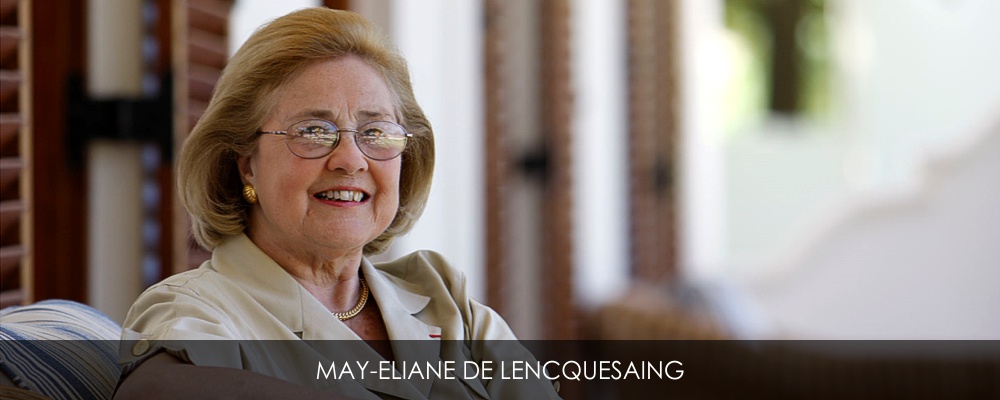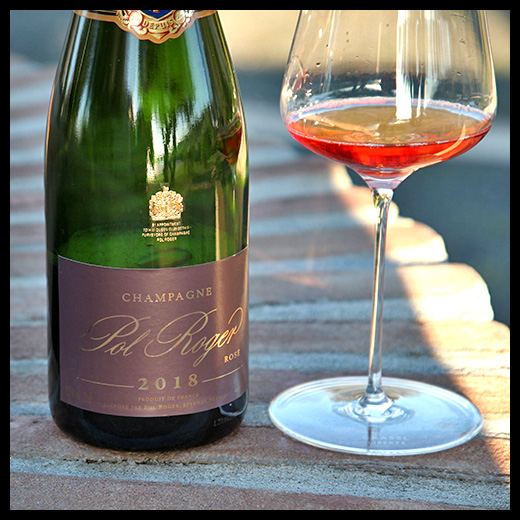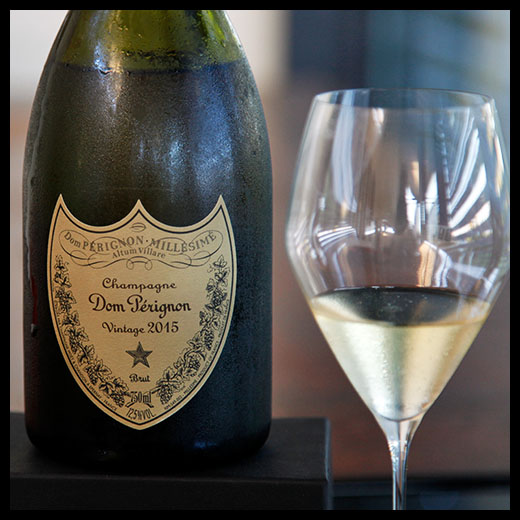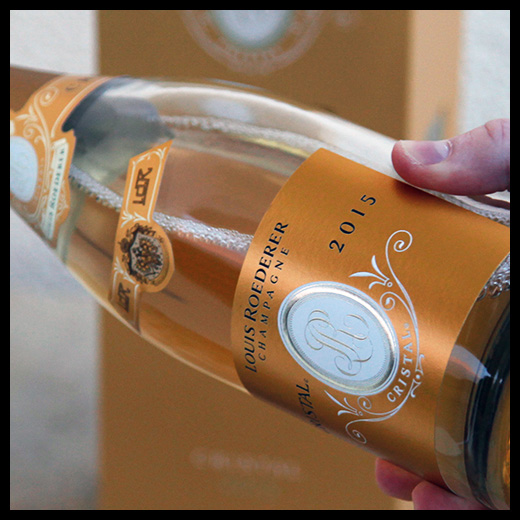"Great wines are like listening to Mozart"
02. Dezember 2015It was only 18 years after the ending of the Boer war that May-Eliane Miailhe was born in 1925 in the city of Bordeaux. But it took eight decades until the conditions in South Africa would allow making top wines again. At the age of 78 she bought a farm in the heart of Stellenbosch and founded her own winery there. In between she lived a rich live full of radical changes and became one of the most influential persons in Bordeaux wine. We feel extremely honored to have had the chance to talk the „Grand Dame“ Bordeaux in a very personal and moving interview.
There are many people who talk a lot, but there are only a few who share stories worth telling. No doubt - May-Eliane de Lencquesaing incorporates the second and we are ready to cock our ears for the next two hours. Meanwhile the "Grande Dame" of Bordeaux has turned 90 and has seen many dramatic changes. One must not forget that the Bordeaux wine of the modern time is a mere 300 years old – meaning she experienced almost a third of the history first-hand. And a few decades of her life were everything but easy.
The years of growing up
May-Eliane de Lencquesaing was born as one of three children. Her parents Edouard Miailhe and Victoria-Charlotte Desbarats were the co-owners of one of the most important wine trading companies together with Edouards brother "uncle Louis". Besides being brokers they also held substantial interests in eight Châteaux, including such illustrous names as Château Palmer, Château Ducru Beaucaillou, Château Pichon Lalande, Château Coufran or Château Citran. It`s almost impossible to believe that a family with such extensive possessions went through difficult times. In the 1920s Europe did still not recover from World War I and there were no sizable markets outside of Europe for Bordeaux wines. On top of this a string of bad vintages in the 1930s made things even more difficult than before. As a consequence the more Châteaux the family owned the worse the economic situation became.
May-Eliane de Lencquesaing remembers very well that the family was hardly able to buy extra food, so most of the food had to be grown on their farm. Being wine producers land was a valuable resource and by the end of the 1930s World War II came over France adding just another disastrous scenario. Many Châteaux had been occupied by German troops and they made no exception with the Miailhe family. Finally the year 1945 brought the much needed change. The war was over and Mother Nature reconciled some of the wounds with a handful of extraordinary vintages in the coming two decades. Until today the outstanding quality of this legendary vintage has no opponents. Unfortunately once again there were no markets for this kind of wine as Europe was mostly destroyed and fine wine was the least product people neither needed nor were able to buy. It was not before the end of the 1950s before that situation changed although more great vintages followed after 1945. For May-Eliane de Lencquesaing the turning point was 1959, the first Vintage that created substantial interest in the US market. Unfortunately her father Edouard Miailhe died that year at the age of only 61, meaning he never saw the recovery of his company which he was fighting for so hardly. And this was just a short time after he and his uncle separated the interests of the two families in the company.
The family years
In 1948 May-Eliane de Lencquesaing married Hervé de Lencquesaing, a young nobleman from the very North of France who was born in 1920. He joined the army to fight the German invaders and was wounded three times. Still after the war he decided to follow a career in the French army where he ended up as a General. His wife May-Eliane followed his numerous assignments and the family had to move 15 times within 30 years. This was a real challenge as the couple had four children and some were foreign assignments. i.e. the family lived in the U.S. for a couple of years. May-Eliane de Lencquesaing comments this time with "my business were my four children" - whatever was left as spare time she invested in social projects for children.
In the 1970s, towards the end of her husband`s career, the family was able to settle down in the North of France where Hervé retired in 1974. May-Eliane de Lencquesaing then started a pretty successful career in politics on her own. Soon she was elected into the local municipality in the Departement of Pas-de-Calais close to the Belgium border. "I was rather leftist and comprehensive of people in need" she insists and makes clear she was elected by Socialist voters. She always felt a strong connection to these people ("that was my place") and a distinct distance to some rich people.
Life seemed stable at this time and May-Eliane de Lencquesaing had found her place to feel comfortable. But this stability was very deceptive as things in Bordeaux did not go into the right direction. After the death of her father her brother William-Alain took responsibility of the wine business. He was still quite young to perform and make proper decisions and the company went bankrupt in 1971. Lawyers took over control and tried to sort things out. In 1978 the lawyers decided to restructure what was left for the three inheritants and called them in. They noted the divided properties on three sheets of paper, folded them and drew lots in the presence of the children. May-Eliane de Lencquesaing unfolded the paper and read that she was the new owner of Château Pichon Longeville Comtesse de Lalande in Pauillac, a second growth.
The years as owner of Pichon-Lalande
For May-Eliane de Lencquesaing this new situation felt like a shock as she immediately knew that it would change her life. She rushed to Pauillac and when she arrived, she was shocked again over the terrible condition the Château was in. Over the next two years she tried to split her life: four days in Pauillac and three days in the North. Even for such an energetic and dedicated person as May-Eliane de Lencquesaing this ended in the hospital. After recovering she tried to reduce traveling, stayed some weeks in Pauillac and some at home. But soon she realized she had to make a decision. With a heavy heart she gave up her mandate in politics and moved to Pauillac together with her husband.
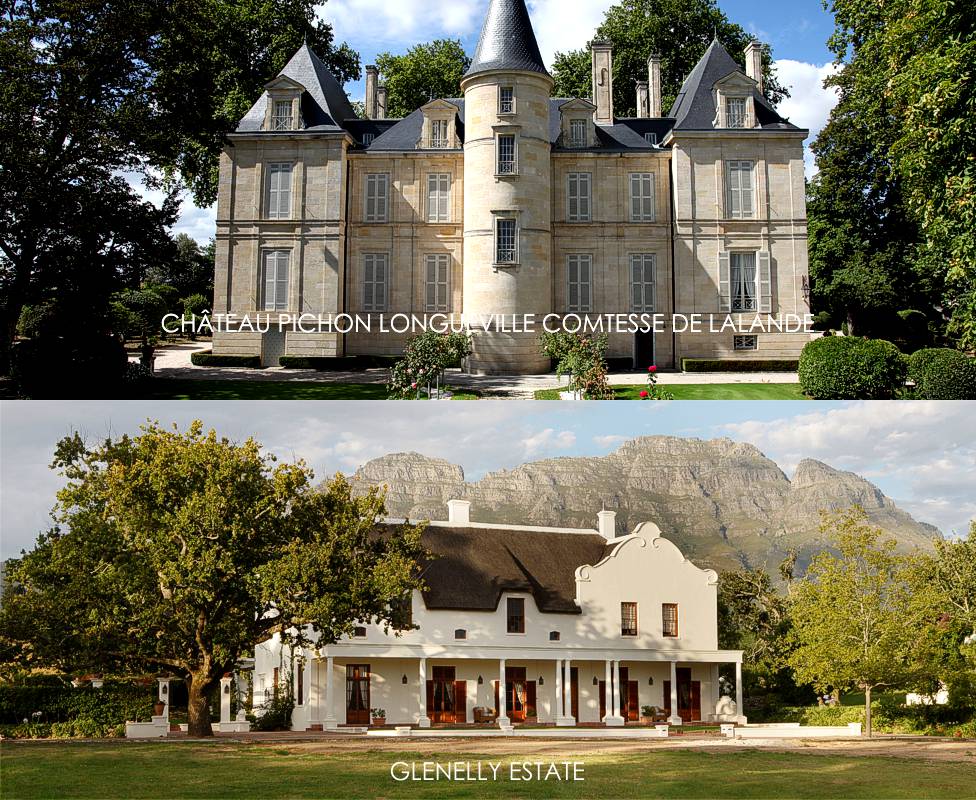
Despite all her energy, discipline and resoluteness she stated that the she was not immediately able to manage a winery. “In the world of wine so much had changed and everything I had learned were experiences my father had passed on in my childhood. At the age of 55 she decided to start her studies of oenology at the University of Bordeaux and reorganized the winery with all its institutions and vineyards. Also she decided to move into the Château with her family although it had only been the second time in 200 years that a family decided to live in the Château all year round – typical for May-Eliane de Lencquesaing. Not even the fact that the first winter was spent without heating could stop her from her ambitions, obviously the Château had not been renovated for over 200 years. In 1926 May-Elianes father was able to use the economic weakness of the pre-owners as an advantage and bought the major share of this well-respected Château. After being in charge, May-Eliane de Lencquesaing was able to buy all other shares of Pichon-Lalande as well.
With an immense success she led Pichon Lalande for over 30 years. Today her wines are known as the best in Bordeaux, their quality is mostly among those of the Premier Cru. No wonder the winery is secretly called to be a „Super-Séconde“, meaning it is rated in the second league while performing like one in the first.
Even though May-Eliane de Lencquesaing was never actually active as an oenologist, she was well-known for choosing a perfect team and having a clear vision of an excellent wine. Three dimensions are needed for perfection: elegance, balance and longevity. She insists on producing a wine which will increase in complexity and ripeness and the method to do so is called assemblage. Combining the perfect amount of different grapes and parcels is the high art of making outstanding wine. With this intention it comes as no surprise that when she was elected President of the IWSC (International Wine & Spirit Competition) in London in 1993 she founded a Trophy for the best blended wine in the world. All wines were always blind tasted and more than one time the winner came from South Africa.
May-Eliane de Lencquesaing compares great wines with music from Mozart. Some instruments can sound delightful when played by themselves; however, the diversity and elegance will never be archived like in an orchestra. And it's the same with great wines that perform through individual perfection of crus, terroir and grapes. Creating a Cuvée like this is similar to composing a symphony.
During the 1970ies the quality went up rapidly and 1975 and 1978 were very good vintages already and were followed in the Far East Singapore, Hong Kong and Japan. These vintages were followed by the first golden decade which started with the incredible 1982 and was continued by 1985, 1986, 1989 and 1990. Also the vintages of 1983 and 1985 were remarkable wines and the markets in the U.S. developed perfectly. On top May-Eliane de Lencquesaing was able to revert to her four years of experience abroad and travelled tirelessly to the U.S. and England, which are still one of the biggest markets for Bordeaux wine. She focused on networking with many wine collectors and of course this strategy did not fail. Then the young Robert Parker gave her 1982 vintage unbelievable 100 points, which was the ultimate accolade for the antique Chateau and had great meaning for the American market.
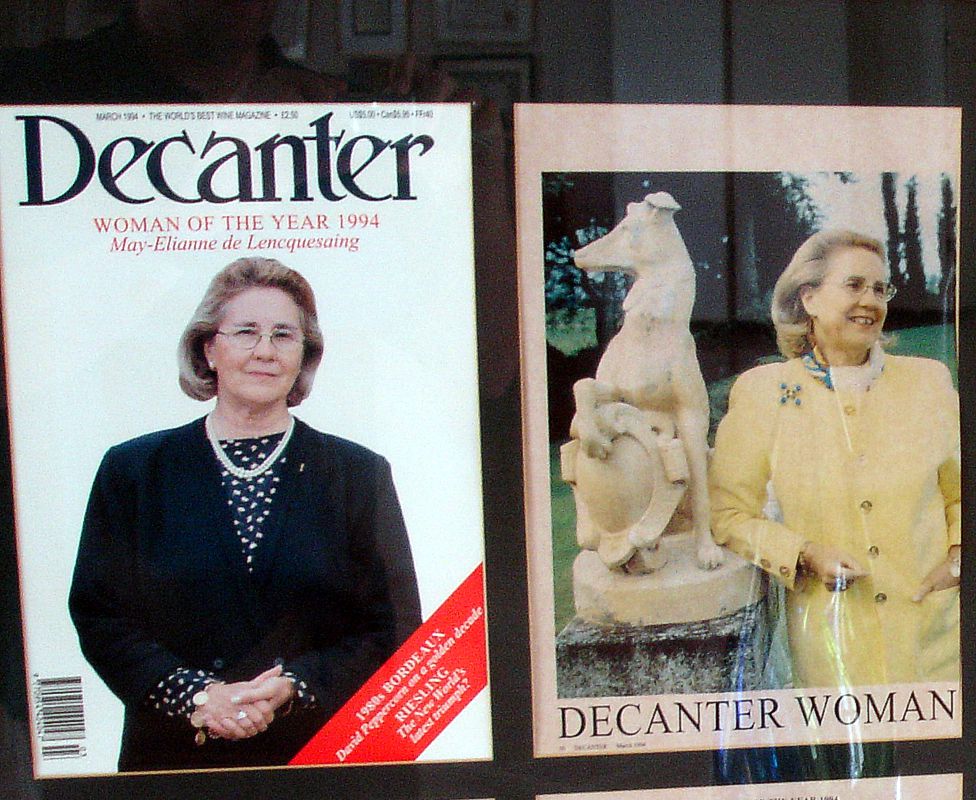
Woman of the Year 1994 by Decanter Magazine
The years of new adventures in South Africa
In 1816 André Jullien published a book called „Topographie de tous les vignobles connus†which became the bible of wine. He wrote about all wines of the world and classified them into five categories. May-Eliane de Lencquesaing underlines that this work was the first and all-embracing piece in wine history. In 1832 a new edition was released and was awarded by the French science academy with a statistics prize - May-Eliane de Lencquesaing has been a member for years and is still active with big enthusiasm. May-Eliane de Lencquesaing also she points out that Stellenbosch in South Africa is rated in the best possible category (category 5) – just like Bordeaux. By the way this was the first ever classification of Châteaux – 40 years before the next one in 1855. However, the classification in 1855 is extremely similar to the one from André Jullien and identical for all Premier Crus and some 2nd and 3rd Crus like Ducru Beaucaillou or Cos d`Estournel.
Her personal connection to South Africa started in 1988 when she travelled there together with eight other couples who were all Negociants or owned wineries. Along came Henri Mähler-Besse and together they visited the most important producers, tasted a lot and made notes, being amazed by the good qualities of the wines. The contacts to the South African wine industry were deepened after Apartheid ended in the beginning of the 1990ies. May-Eliane de Lencquesaing regularly invited oenologists to Pichon Lalande to exchange experiences and enabled a good contact from the University of Bordeaux to the University of Stellenbosch, the most important educational establishment for wine in South Africa. Several travels to South Africa brought her closer to potentials and problems they were facing.
In the end it was Anton Rubert from Stellenbosch who motivated May-Eliane de Lencquesaing to invest in South Africa herself. He is also one of the most successful entrepreneurs from South Africa since parts of his activities are today known as the luxury conglomerate Richemont (Cartier, Mont Blanc). He underlined the importance of French people engaging in this region, since many Huguenot fled here from France a long time ago. But May-Eliane de Lencquesaing was looking for a small farm since she did not want to ask too much of herself at the age of 80. It was extremely important to her to show her 10 grandchildren that even in the year 2003 there were adventures worth engaging in.
She was always busy with Pichon Lalande and although she had nearly no time to find a suitable farm she knew exactly what she was looking for: a perfect hillside situation with excellent water offtake and lots of sun exposure. And she knew very well that a location with circumstances like these is quite rare. On top she didn't want to buy an already existing winery since the vine fretter had also devastated South Africa and she could not afford to rip out the vine, clean the soil and plant completely new. Quickly she found the Glenelly Estate, a fruit farm that gave up growing wine after the vine fretter. She immediately fell in love with this beautiful piece of land which was nearly perfect but one thing: it was way too big with its 120 hectare land. The salesman was pushy and so the acquisition was processed quickly. In 2004 they planted 60 hectares with the classy Bordeaux vines and some Chardonnay due to its big tradition in South Africa and some Syrah, since Stellenbosch is closer to the equator and therefore has a warmer climate than Bordeaux. While setting up the Glenelly Estate the thought of selling the beloved Pichon Lalande was always present since none of the four children had an interest in actively continuing it.
The years between Stellenbosch and Bordeaux
After May-Eliane de Lencquesaing had lost her husband Hervé in 1990 she was forced to lead the Château by herself and did so with huge enthusiasm. Leaving this property behind must have been hard for her, even today she doesn't want to speak about it background of this decision. But one can feel that there was no perspective to keep the Château in the family. Initially the Hèrmes-family, majority holder of the French luxury conglomerate Hèrmes, was interested in buying it. Their philosophyof running the winery was very much alike May-Eliane de Lencquesaings and she would have appreciated the take-over by Hèrmes. However, the sale never went through and in 2007 the Château was sold to Frédéric Rouzaud who is running the Champagne house Roederer in the 7th generation. For May-Eliane de Lencquesaing this was the end of an era, because „Roederer had a different philosophy“. Meanwhile Pichon Lalande was renovated completely and the wine making facility and the Chai is now replaced by a brand new building.
The sale went through to the same time they invested huge sums in building up Glenelly from scratch. But no one can buy the time the vines need to grow deep into the ground, however in 2007 the team started adding own grapes to the Glenelly wines. In 2010 May-Eliane celebrated her 85th birthday, a perfect occasion to also celebrate the inauguration of the new Glenelly winery. Two of her ten grandchildren are actively working for Glenelly and one more is in the wine business in France. Grandchild Nicolas Bureau represents Glenelly from his London office in export sales and marketing and relentlessly travels the world to promote his wines. This is very important as export sales make up 50% of total sales with the key markets in the US, England, Belgium, Germany and Hong Kong. It is amazing to learn that despite the perfect connection of the family to the French wine distribution network Glenelly does not succeed in selling South African wine to the French consumer. It is very important for May-Eliane to insist that all wine shipments abroad are handled in temperature controlled containers, a prerequisite to preserve the quality of the wines. As this costly option had just not existed in former times, the South African wines very often arrived in the export markets in very bad condition, a root cause for the bad reputation of these great wines.
Of course May-Eliane de Lencquesaing is very well aware that South African wine enters the world stage of fine wine very late and consumers today have so many other options to buy premium wines from emerging wine regions between New Zealand and Chile. As the best wine making knowledge is readily available everywhere in the world today, the gap in quality is disappearing more and more. But May-Eliane has discovered a unique value proposition for South African wines as they are the only New World wines that are similar to the cold climate characteristics of European wines with a much lower price tag. This is especially true for Glenelly wines, a strong selling point in many export markets that needs to get a lot more attention. She also knows that in order to achieve that Glenelly wines need more visibility in the target markets. Wine tourism is also becoming an increasing factor as wine consumers love to travel the wine regions and visit their favorite producers. The beauty of the Cape region magically attracts an increasing number of tourists that don´t miss the wine country.
At the age of 90 the “Grande Dame†still travels between Bordeaux and Stellenbosch every two months. As travelling always was a part of her life she does not mind the long trip. Departing in London in the evening she can perfectly sleep in the plane directly to Cape Town, have breakfast still in the plane and immediately feel home in South Africa that is only one hour ahead of Bordeaux. But something she really hates is heavy administration. Unfortunately from time to time she can´t avoid having a look at all her files. She makes no compormise when it comes to educating her employee's children. She personally cares that all kids can go to high school for a better future for the next generation. Still a well-educated and experienced generation of black winemakers and oenologists is not available in South Africa but needed so desperately. Therefore the white wine farmers still seem to match the old bogeyman of the black government of South Africa who hate this upcoming wine business. It really hurts her old socialist soul that it was not yet possible to convince the Officials that the old prejudices just are no longer true.
Her deep rooted humanity is only matched by her love of books, literature and political science. She is still a proud and active member of the Academy of Science in Bordeaux and always looks forward to the weekly luncheons that inspire her. But she also insists that she still is simply the “farm girl†she always was, grown up outdoors in the vineyards with roots to the soil as deep as the vines.
An example for the young generation
Six out of her today nine decades May-Eliane de Lencquesaing has been in intimate contact with the greatest wines of Bordeaux. She has seen economic decline and boom periods with cycles that in wine much like in art are measured in decades rather than in years. It made her modest and think in generations and very long term tradition. Typically vines are planted by the parents and harvested by the grandchildren. Talking to her one can feel her excitement and addiction to the magic of old bottles of wine. She always comes back to the ability of great wines to age for many decades. The Glenelly rootstocks definitely need a lot more time to develop this ability but time is on their side.
May-Eliane de Lencquesaing ist well aware that her life is an example for the young generation. With great energy and relentless optimism she always adjusted within a short time to whatever was necessary to do. For her knowing that there will most likely only be a few more years to come is “a disasterâ€. “Money has no meaningâ€, she says. “You are born naked and will die the same way. What is only important in life is that in the time in between you have to take care of the people that join you on your path for some yearsâ€. She definitely is a “Grande Dameâ€, not only in wine.

